Site WW10
Location: Lillimur
Australian Soil Classification: Endocalcareous-Endohypersodic, Self-mulching, Grey VERTOSOL
Northcote Factual Key: Ug5.2
Great Soil Group: grey clay
General Landscape Description: Level plain. These cracking clay soils are often found in association with lakes or on plains between rises. This soil type is regarded as the most appropriate to represent the gently undulating clay plains land unit. A large area of these soils can be found around Neuarpur where irrigated white clover is grown for seed production.
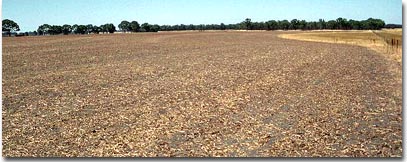 Site WW10 Landscape |
Soil Profile Morphology:
Surface Soil
| A1 | 0-10 cm | Dark grey (10YR4/1) light clay; moderate blocky structure (peds 20-50 mm); very firm consistence when dry; pH 7.8; clear transition to: | 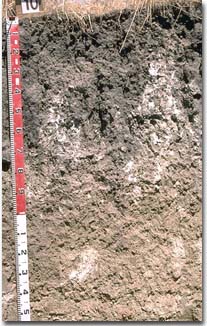 Site WW10 Profile |
| Subsoil | |||
| B21 | 10-75 cm | Dark grey (10YR4/1) medium clay; strong blocky structure, (peds 20-50 mm); smooth fabric; strong consistence when dry; pH 8.6; gradual and tongued transition to: | |
| B22K | 75-100 cm | Light grey (2.5Y7/2) light medium clay; strong blocky structure, (peds 20-30 mm); very strong consistence when slightly moist; many (10-30%) soft and semi-hard calcium carbonate segregations; pH 9.4: | |
| B23 | 100-200 cm+ | Light grey (2.5Y7/2) medium heavy clay; a few red mottles; prismatic structure parting to strong polyhedral structure, (peds 10-20 mm); patches of soft calcium carbonate segregations and a few hard calcium carbonate and iron/carbonate/silica segregations; pH 9.4. | |
Horizon | pH | Salinity | Internal Drainage | Hydro- phobicity | ||
Surface (A1 horizon) | slightly alkaline | low | non-sodic | nil | moderately well drained | nil |
Subsoil (B21 horizon) | strongly alkaline | low | sodic | slight1 | - | - |
Deeper subsoil (at 1 metre) | very strongly alkaline | high-very high | strongly sodic | none2 | - | - |
2 Possibly due to the high levels of soluble salts.
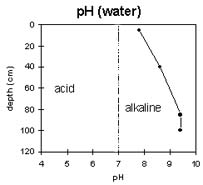 | 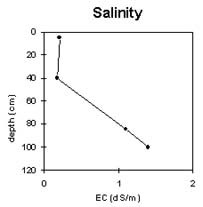 | 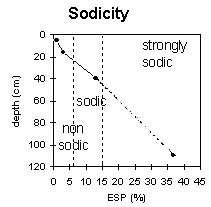 | 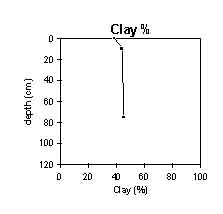 |
Key Profile Features:
- Surface condition slightly self-mulching. Surface becomes more self-mulching following cultivation.
- Sodic clay subsoil.
- Subsoils will disperse following cultivation when wet.
- Presence of a carbonate horizon.
- Alkaline subsoil.
- High soil salinity at 75 cm.
- Gilgai characteristics results in uneven depth of carbonate.
- Uniform clay throughout profile.
Feature | Result | Management Prescription |
| Sodic clay subsoil. |
|
|
| Dispersion when reworked. |
|
|
| Carbonate layer (lime). |
|
|
| Alkaline subsoil. |
|
|
| Soil salinity at depth. |
|
|
Land Suitability Rating Table:
LAND USE | SUITABILITY CLASS | MAJOR LIMITING COMPONENT |
| Wheat | 2 | Climate, soil |
| Canola | 2 | Climate, soil |
| Chickpeas | 2 | Climate, soil |
| Lentils | 2 | Climate, soil |
| White clover seed | 2 | Soil |
| Lucerne for seed production | 2 | Soil |
| Viticulture | 2 | Climate, soil |
| Apples | 3 | Soil |
| Potatoes | 3 | Soil |
| Carrots | 3 | Soil |
| Onions | 3 | Soil |
| Sweet corn | 2 | Climate, soil |
| Radiata Pine | 3 | Climate |
| Blue Gum | 3 | Climate |
Land Suitability Assessment and Primary Limitations:
| Wheat | Climate | 2 | Moderate frost risk, slightly high rainfall. |
| Landscape | 1 | No major limitation. | |
| Soil | 2 | Slightly alkaline subsoil pH. | |
| Canola | Climate | 2 | Moderate frost risk. |
| Landscape | 1 | No major limitation. | |
| Soil | 2 | Slightly alkaline subsoil pH. | |
| Chickpeas | Climate | 2* | Moderate to high rainfall, moderate frost risk. |
| Landscape | 1 | No major limitation. | |
| Soil | 2 | Slightly impeded internal drainage, subsoil texture, slightly alkaline subsoil pH, soil salinity. | |
| Lentils | Climate | 2 | Slightly high rainfall, moderate frost risk. |
| Landscape | 1 | No major limitation. | |
| Soil | 2 | Slightly impeded internal drainage, subsoil texture, slightly alkaline subsoil pH, soil salinity. | |
| White clover seed | Climate | 1 | No major limitation. |
| Landscape | 1 | No major limitation. | |
| Soil | 2 | Slightly alkaline pH, soil salinity. | |
| Viticulture | Climate | 2 | Moderate frost risk. |
| Landscape | 1 | No major limitation. | |
| Soil | 2 | Slightly alkaline subsoil pH, soil salinity, slightly impeded internal drainage. | |
| Apples | Climate | 2 | Slight frost risk, slightly high mean maximum January temperature. |
| Landscape | 1 | No major limitation. | |
| Soil | 3 | Alkaline subsoil. | |
| Potatoes | Climate | 2 | Slightly high mean maximum January temperature. |
| Landscape | 1 | No major limitation. | |
| Soil | 3 | Alkaline topsoil pH. | |
| Lucerne for seed production | Climate | 1 | No major limitation. |
| Landscape | 1 | No major limitation. | |
| Soil | 2 | Slightly alkaline subsoil pH, slightly impeded internal drainage. | |
| Carrots | Climate | 1 | No major limitation. |
| Landscape | 1 | No major limitation. | |
| Soil | 3 | Alkaline topsoil pH. | |
| Onions | Climate | 2 | Moderate frost risk. |
| Landscape | 1 | No major limitation. | |
| Soil | 3 | Alkaline topsoil pH. | |
| Sweet corn | Climate | 2 | Slightly low mean monthly temperature (October - March). |
| Landscape | 1 | No major limitation. | |
| Soil | 2 | Slightly alkaline topsoil pH, slightly impeded internal drainage. | |
| Radiata Pine | Climate | 3 | Low rainfall. |
| Landscape | 1 | No major limitation. | |
| Soil | 2 | Depth of topsoil, slightly alkaline pH. | |
| Blue Gum | Climate | 3 | Low rainfall. |
| Landscape | 1 | No major limitation. | |
| Soil | 2 | Depth of topsoil, slightly alkaline pH. |
Profile Described By: Mark Imhof, Nathalie Baxter (08/01/97).


